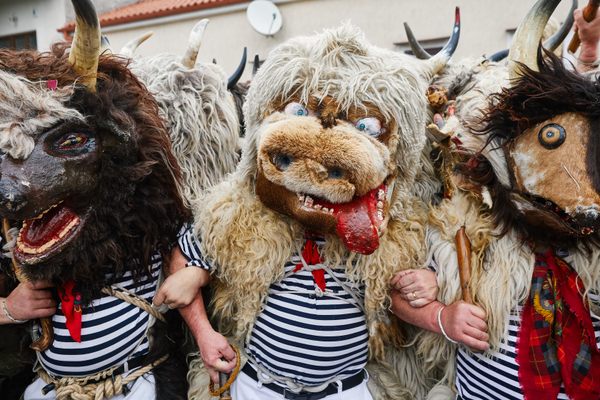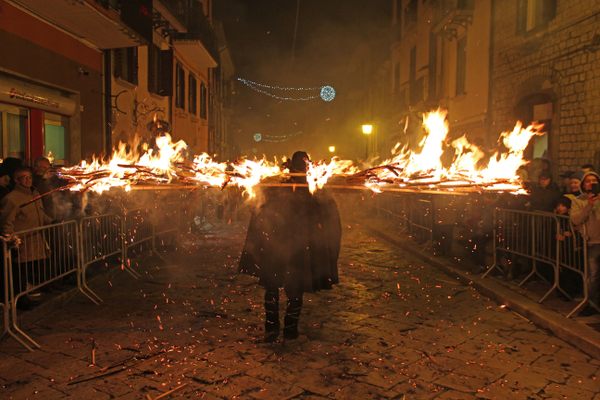Stasi Surveillance in the Shadows of the World’s Largest Goth Festival
Just two days after the world’s largest goth festival had extinguished the candles for another year and the dark masses had left Leipzig, construction workers around the East German city’s main station unearthed a WWII bomb. My train was delayed as hundreds of people were evacuated so that the 160lb US explosive could be detonated. It was a reminder that Leipzig has experienced its fair share of darkness over the past century, and continued to do so for decades after the war, until 1989 when non-violent protests began locally and grew into a revolution that played a key role in the destruction of the Berlin Wall.
With more than 20,000 brooding revelers descending on the idyllic city of Leipzig for the Wave-Gotik-Treffen in June this year, an exhibition at the Stasi ‘Runde Ecke’ Memorial Museum revealed the secret history of the ministry’s persecution and surveillance of goths, punks, and any subculture that had a whiff of The Cure about them.
Die Gedenkstätte Museum in der Runde Ecke, the former offices of the Stasi in Leipzig
Awaiting the tour guide on the round street corner that gives the museum its name, the variously Doc Martened, mohawked, and leather-corseted members of our party must have looked like we had been rounded up for interrogation. I almost believed it myself, seeing that the museum sprung from the former building of the Stasi district headquarters. Leipzig is the only place in Germany where the original MfS offices have been preserved as a public memorial, down to the peeling linoleum, barred windows, security cameras and, the staff claim, “the typical GDR smell” lingering in the musty hallways.
We crept past a row of stern-looking filing cabinets as our guide presented us with internal reports from the 1980s on how the secret police documented counterculture factions, interviewed underage goths to ask them to spy on their friends, and prevented some from attending university. (There were staged readings from these files throughout the festival.) The SSS took cloak-and-dagger espionage to the next level — just not the kind of cloaks and daggers goths like.
Photo by Ulrike Horak
The “Schwarze Szene” (black scene) popped up relatively late in Leipzig around 1986 (with a whopping 85 goths known to the authorities by March 1989), whereas punks already had an established presence. The SSS, which took particular interest in investigating “unsozialistisches Aussehen” (anti- or un-socialist traits) lumped them in with the files on “Negativ und Dekadent” groups, profiled in a handy illustrated chart helping officers and informants recognize Gruftis or Gotiks, Heavy metals or “heavys,” Skinheads, Punks, New Romantics, Teds (rockabilly teddy boys), and Poppers. A confusing flow-chart was created to clarify the relationship between these and their various subgroups and assess the threat they posed — Anarchie-punk and Nazi-punk, Psycho-billy, Satanisten, and the classic Hooligan among them. I don’t speak German. “What’s a Schmuddel-punk?” I wondered, “And is it anything to do with strudel?”
Gruftis were thought to exhibit the following characteristics: being 15-20 years old (“I’m leaving!” grumbled a middle-aged Mancunian goth within our group), Satan worshippers, fans of the band The Cure, disinterested in politics and society, or grave desecrators. And, most prominently: an “extrem pessimistische Einstellung” (extremely pessimistic attitude).
‘Personifizierung’ of a Grufti
I don’t know about that last one. (Grave desecration, on the other hand…) In many of the group photos the Stasi managed to get hold of — with each individual’s eyes eerily blackened out by the censors — everyone seems pretty comfortable hanging out with their friends, most sporting something that resembles a half-smile. And looking around the tour group and at other Wave-Gotik-Treffen visitors exploring the museum, they all seemed pretty cheery; sufficiently interested in society and politics to learn about how the Stasi trespassed on their peers.
I also noticed that a good portion of festival-goers shuffling about as fast as their creepers or vinyl platforms can carry them were in their forties — the right age to have been part of the original generation of persecuted teenagers. WGT is not just a youth-oriented event as one might expect: one purple-haired Dutch couple from the Stasi Museum tour told me they have been coming to the festival for twenty years (it’s just wound up the 23rd edition), and some have started to bring their children.
At the Wage-Gotik-Treffen Festival in Markt, Leipzig
Wave-Gotik-Treffen, too, was initially a victim of the GDR witch-hunt. The first Treffen, or gathering, was staged in Postdam in 1988, but was deemed illegal and only a few hundred visitors risked attending. It wasn’t until after reunification that the festival was launched in Leipzig.
It has since expanded and diversified to include so many subgroups that the Stasi would never have been able to keep track. Wandering through the camping grounds, the vast Südfriedhof (South Cemetery), or the Brühl boulevard in the main city center, I saw that steampunk seemed to be the order of the day, but pagans and vikings were out in full force, perhaps partly thanks to Game of Thrones. The Clara-Zetkin-Park’s Victorian picnic is in actual practice a relaxed mixer: among the unwieldy bustles and yards of black lace I spied fairies, punks, rivetheads (that last one I had to look up), and a proliferation of kilts.
Just being a goth or similar is a lot of work in the searing sun, with this year’s festivities falling on one of the hottest Whitsun weekends on record. I discovered the best trick is to take refuge under the cool marble of the St Nicholas Church. Surely no one who arrives at a dark music and arts festival with a carefully maintained vampiric complexion expects to leave with a golden tan, but those black parasols are no match for sunny Leipzig.
Kids in awe at the WGT Victorian Picnic
Which begs the question: why Leipzig? The city is known as the German “Musikstadt” where Bach composed his greatest masterpieces, and as the birthplace of Richard Wagner, one of classical music’s great titans and, inconveniently, one of the 19th century’s most infamous anti-Semites. It might seem just a tad incongruous to glance at the WGT line-up and try to choose between the bands Christian Death, Kiss the Anus of a Black Cat, and The Revolutionary Army of the Infant Jesus. Mind you, the annual Bach Festival runs a battle of the bands called Bachspiele, won in 2012 by local sadcore group Molllust, who played WGT this year. Their “opera metal” take on Bach’s aria Blute nur, du liebes Herz features angsty lyrics from the Matthew Passion that could have been penned by Evanescence: “Bleed on, dear heart/Ah, a child…threatens to murder its guardian/For it has become a serpent.”
Leipzig’s long and distinguished history is an integral part of what makes WGT so special. The pride of the city is its 800-year-old gothic church, the Thomaskirche. If you really are into Satan worship, as Stasi officials suspected, the Auerbachs Keller is just a few minutes’ skulk away. The 15th-century tavern is still cashing in on Goethe’s enthusiastic patronage during his studies in Leipzig between 1765 and 1768 — it was to become Mephistopheles’s den of choice in Faust. You can see the thriving contrast between Leipzig’s classical and punk scenes literally on every street corner, the elegant Wilhelminian buildings covered with graffiti and hand-drawn posters for noise rock gigs in Connewitz.
And still, it’s a tranquil town. Even when it’s taken over by a crowd of 20,000 souls in strange black regalia, the locals are welcoming, enjoying the spectacle as they go about their business. I asked repeat visitors from all over the world why they keep coming back, and the answer most gave me was that it’s “peaceful,” “everyone respects one another,” and “there’s no violence.” This is absolutely the way things should be in Leipzig, seat of the Friedliche Revolution (Peaceful Revolution).
For three nights during WGT, I was hosted by a classical musician based in the suburb of Plagwitz, and slept literally in the shadow of the harpsichord in his living room. (Do I get goth points for that?) According to my harpsichordist friend, if Leipzig were a person, it would be a rebellious teenager with conservative parents, just at the point of deciding what to do with his life. Perhaps the goths will give him a nudge in the right direction.
All photographs by the author unless indicated.























Follow us on Twitter to get the latest on the world's hidden wonders.
Like us on Facebook to get the latest on the world's hidden wonders.
Follow us on Twitter Like us on Facebook